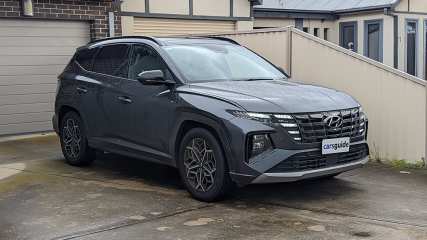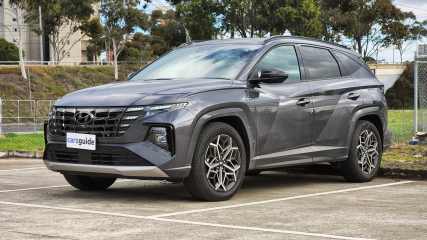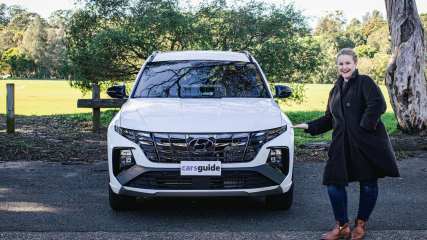Hyundai Tucson 2022 review: Highlander N Line diesel AWD long-term | Part 4
By Tung Nguyen · 31 Aug 2022
Variety might be the spice of life, but too much choice can lead to confusion.If it wasn’t bad enough trying to work out what you want in your burrito (chicken, beef, shredded pork, beans, fish, plant-based protein, tofu, etc), well, you also have a decision between three powertrains with the Hyundai Tucson.As we’ve stated in previous reviews, the base engine is a 2.0-litre petrol with 115kW/192Nm, the mid-spec version is a 1.6-litre turbo-petrol engine with 132kW/265Nm, and our top-spec car comes with a 2.0-litre turbo-diesel delivering 137kW/416Nm.But aside from varying outputs, what are the tangible differences between the engines?Luckily, I’ve spent some time in a base 2.0-litre car recently to see if the seat-of-the-pants feel is any different from the diesel, and whether you should stump up the extra cash for the oil burner.The first thing you have to consider is that the 2.0-litre engine is available in front-wheel drive guise only, while the diesel offers up all-wheel drive traction. So, if the driven wheels are a deal-breaker for you, you can stop reading now (but you should probably keep going!)However, the benefit of being front-drive is less kerb weight, with the petrol nearly 250kg lighter than the diesel.This affords the Tucson with the 2.0-litre engine a similar power-to-weight ratio as the more potent and turbocharged diesel, at 75.3kW per tonne versus 77.3kW/T.What’s all this mean in the real world? Well, the two engines perform much closer off-the-line than you might expect.Both engines need to be worked at a bit to get them into their sweet spot, with the 2.0-litre working hard to make its peak power at 6200rpm, and the diesel needing to overcome its low-end gruffness and laggy turbo before providing you with a good shove.This means both engines are a little gruff and unrefined when trying to come away from a set of traffic lights at speed, so keep that in mind. But when travelling at speeds below 60km/h in the inner-city during childcare drop off, the differences between both engines are negligible.What is noticeable, however, is when you get out onto the freeway. And that’s because the petrol engine is fitted with a six-speed automatic, while the diesel has eight ratios to play with.That means at 100km/h, the diesel is at a much lower RPM, and the cabin is quieter and more civilised.That isn’t to say the petrol engine isn’t comfortable at freeway speeds, but the 2.0-litre definitely feels like it’s working harder.This also has an effect on fuel economy, with the diesel returning a 6.3L/100km figure compared with the petrol’s 8.1L/100km stated claim for the combined cycle.In the real world we achieved figures of 8.6 and 10.1L/100km for the diesel and petrol respectively.And these numbers are definitely felt at the bowser, with diesel prices at the time of writing surpassing petrol.In fact, this skews the cost equation of spending more up-front on a diesel to save more at the bowser.Quick back of the envelope maths reveals that to recoup the $6000 price premium on the diesel engine, you would have to travel over 500,000km before the fuel savings in the oil-burner start to make sense.And if it’s a factor of equipment level, well, the petrol can be had in base, unnamed Tucson form, Elite and Highlander, while the diesel is offered in Elite and Highlander variants only.The sporty N Line upgrade pack is also available to all Tucsons, so gear will be comparable across both engines, as will aesthetics.One final thing to consider is that diesels are quickly falling out of favour as the world transitions to an electric future.It makes buying a new diesel-powered SUV in 2022 a bit of a hard recommendation, as the current (or soon to be current) crop of vehicles that are available now are likely to the last generation of vehicles offered with oil-burning power.We’ve already seen the likes of the Ford Escape, Toyota RAV4, Honda CR-V, Mitsubishi Outlander and Subaru Forester abandon diesel engines in recent years, so how much longer before the Hyundai Tucson joins their ranks?If Hyundai serves up a hybrid version of the Tucson locally – whether that is with a series-parallel like Toyota’s RAV4 or a plug-in hybrid like the Mitsubishi Outlander – that would easily be the go-to for the 2023 Tucson range.But as it stands, we reckon the figures don’t quite stack up for the diesel-powered Tucson, and you should opt for petrol. Either the base 2.0-litre, if FWD will do you, or the 1.6-litre turbo if you absolutely must have AWD.The only advantage the diesel engine affords is the prodigious driving range, superior torque figure and a better braked towing capacity. But in everyday scenarios, we’d pick a petrol Tucson.Acquired: March 2022Distance travelled this month: 764kmOdometer: 5937kmAverage fuel consumption for July: 8.6L/100 (measured at the pump)
.jpg)
.jpg)
.jpg)
.jpg)
.jpg)
.jpg)
.jpg)


